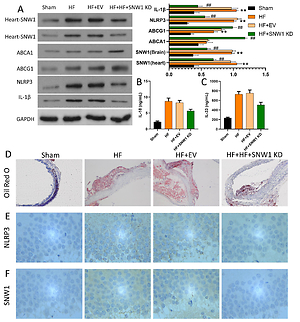Current issue
Archive
Manuscripts accepted
About the Journal
Editorial office
Editorial board
Section Editors
Abstracting and indexing
Subscription
Contact
Ethical standards and procedures
Most read articles
Instructions for authors
Article Processing Charge (APC)
Regulations of paying article processing charge (APC)
NEUROLOGY / RESEARCH PAPER
Knockdown of SNW1 ameliorates brain microvascular endothelial cells injury by inhibiting NLRP3 inflammasome activation
1
The 971th Hospital of the Navy, China
2
The 960th hospital of PLA, China
Submission date: 2021-05-25
Final revision date: 2021-09-26
Acceptance date: 2021-11-01
Online publication date: 2021-11-21
KEYWORDS
TOPICS
ABSTRACT
Introduction:
SNW domain containing 1 (SNW1), as a splicing factor to regulate the activity of transcription factors, has been reported to be involved in multiple disease processes, including neuroblastoma. Whereas, the latent function and concrete mechanism of SNW1 in brain microvascular endothelial cells (BMECs) have not been clarified.
Material and methods:
BMECs were induced by oxidized low-density lipoprotein (ox-LDL), and high fat (HF)-fed rats were established. After SNW1 knockdown or NLR family pyrin domain containing 3 (NLRP3) overexpression, SNW1 and NLRP3 expressions were monitored via RT-qPCR, Western blot, or immunohistochemistry assays. Also, cell viability, apoptosis, and cholesterol efflux were determined via CCK-8, flow cytometry, and related kits; IL-18 and IL-3 levels were also certified by ELISA kits; and NLRP3 inflammasomes and cholesterol efflux-related proteins were identified by Western blot in vitro and in vivo.
Results:
We discovered that ox-LDL or HF-feeding significantly elevated SNW1 and NLRP3 expressions, and prominently induced BMECs injury in BMECs or rat brain tissues. Subsequently, our data confirmed that SNW1 knockdown markedly accelerated cholesterol efflux and viability, and prevented apoptosis and NLRP3 inflammasomes, which also could be reversed by NLRP3 overexpression in ox-LDL-induced BMECs. In addition, we showed that SNW1 knockdown could signally induce cholesterol efflux and repress NLRP3 inflammasome activation in HF-fed rats.
Conclusions:
We demonstrated that SNW1 knockdown has a great protection effect on the dysfunction of BMECs by inhibiting NLRP3. So, SNW1 might be a therapeutic target for BMECs injury.
SNW domain containing 1 (SNW1), as a splicing factor to regulate the activity of transcription factors, has been reported to be involved in multiple disease processes, including neuroblastoma. Whereas, the latent function and concrete mechanism of SNW1 in brain microvascular endothelial cells (BMECs) have not been clarified.
Material and methods:
BMECs were induced by oxidized low-density lipoprotein (ox-LDL), and high fat (HF)-fed rats were established. After SNW1 knockdown or NLR family pyrin domain containing 3 (NLRP3) overexpression, SNW1 and NLRP3 expressions were monitored via RT-qPCR, Western blot, or immunohistochemistry assays. Also, cell viability, apoptosis, and cholesterol efflux were determined via CCK-8, flow cytometry, and related kits; IL-18 and IL-3 levels were also certified by ELISA kits; and NLRP3 inflammasomes and cholesterol efflux-related proteins were identified by Western blot in vitro and in vivo.
Results:
We discovered that ox-LDL or HF-feeding significantly elevated SNW1 and NLRP3 expressions, and prominently induced BMECs injury in BMECs or rat brain tissues. Subsequently, our data confirmed that SNW1 knockdown markedly accelerated cholesterol efflux and viability, and prevented apoptosis and NLRP3 inflammasomes, which also could be reversed by NLRP3 overexpression in ox-LDL-induced BMECs. In addition, we showed that SNW1 knockdown could signally induce cholesterol efflux and repress NLRP3 inflammasome activation in HF-fed rats.
Conclusions:
We demonstrated that SNW1 knockdown has a great protection effect on the dysfunction of BMECs by inhibiting NLRP3. So, SNW1 might be a therapeutic target for BMECs injury.
We process personal data collected when visiting the website. The function of obtaining information about users and their behavior is carried out by voluntarily entered information in forms and saving cookies in end devices. Data, including cookies, are used to provide services, improve the user experience and to analyze the traffic in accordance with the Privacy policy. Data are also collected and processed by Google Analytics tool (more).
You can change cookies settings in your browser. Restricted use of cookies in the browser configuration may affect some functionalities of the website.
You can change cookies settings in your browser. Restricted use of cookies in the browser configuration may affect some functionalities of the website.



